Leadership and Change Management: An Analysis of Theories
VerifiedAdded on 2021/04/21
|14
|3653
|762
Essay
AI Summary
This essay delves into the multifaceted realm of leadership and change management, providing a comprehensive overview of various leadership styles and their practical implications within contemporary business environments. The introduction highlights the increasing challenges faced by organizations, emphasizing the significance of human resources and effective leadership in navigating intense market competition and dynamic environmental factors. The essay explores the critical relationship between motivation and leadership, using Maslow's hierarchy of needs to illustrate how leaders can meet employee needs and foster engagement. It then examines several key leadership theories, including transactional, transformational, and autocratic styles, discussing their strengths, weaknesses, and applicability in different organizational contexts. The essay further analyzes leadership principles, such as the path-goal and contingency theories, and behavioral theories, to determine the ideal qualities of effective leaders. By critically evaluating different perspectives and providing insightful analysis, the essay offers a valuable resource for students seeking to understand the complexities of leadership and change management.
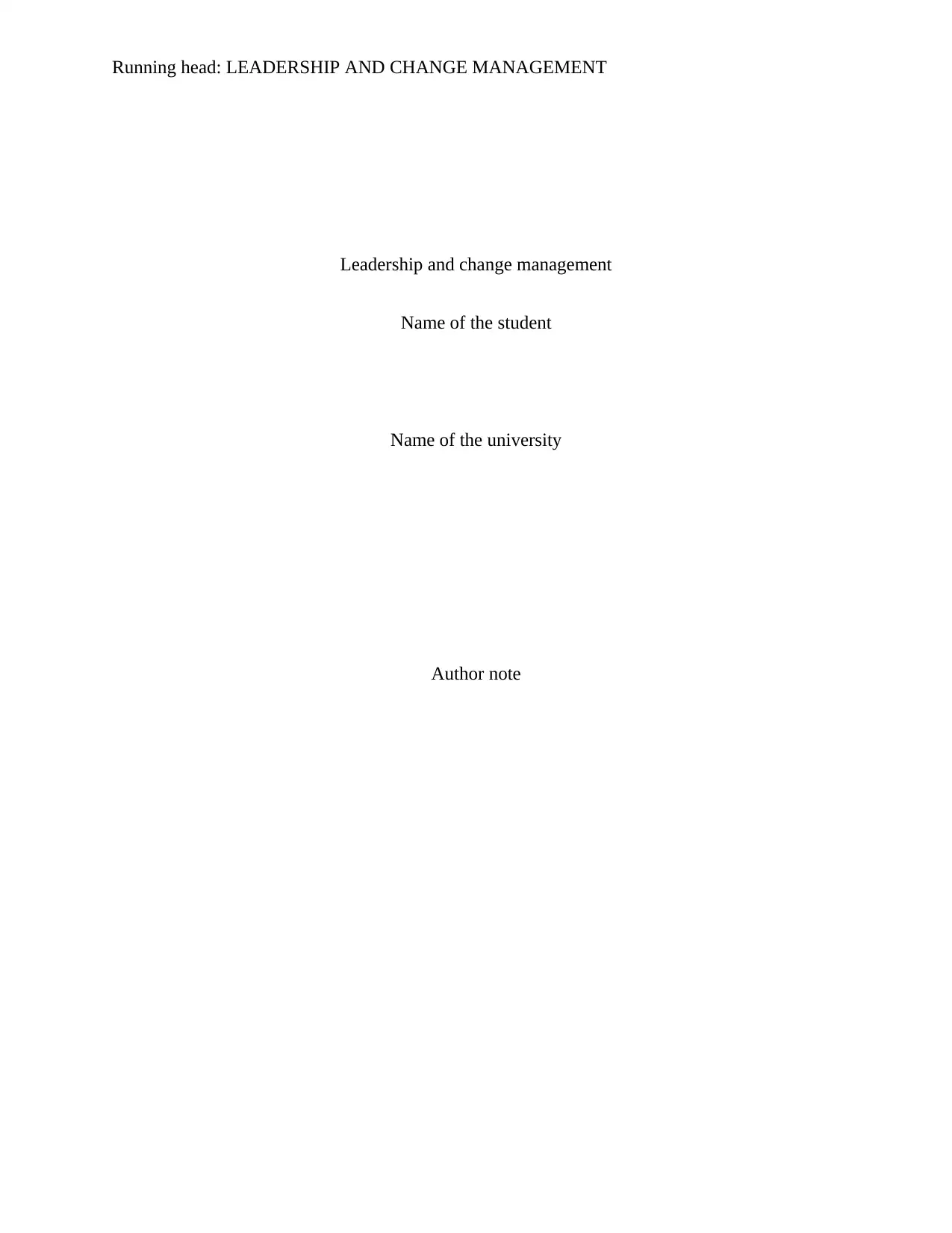
Running head: LEADERSHIP AND CHANGE MANAGEMENT
Leadership and change management
Name of the student
Name of the university
Author note
Leadership and change management
Name of the student
Name of the university
Author note
Paraphrase This Document
Need a fresh take? Get an instant paraphrase of this document with our AI Paraphraser
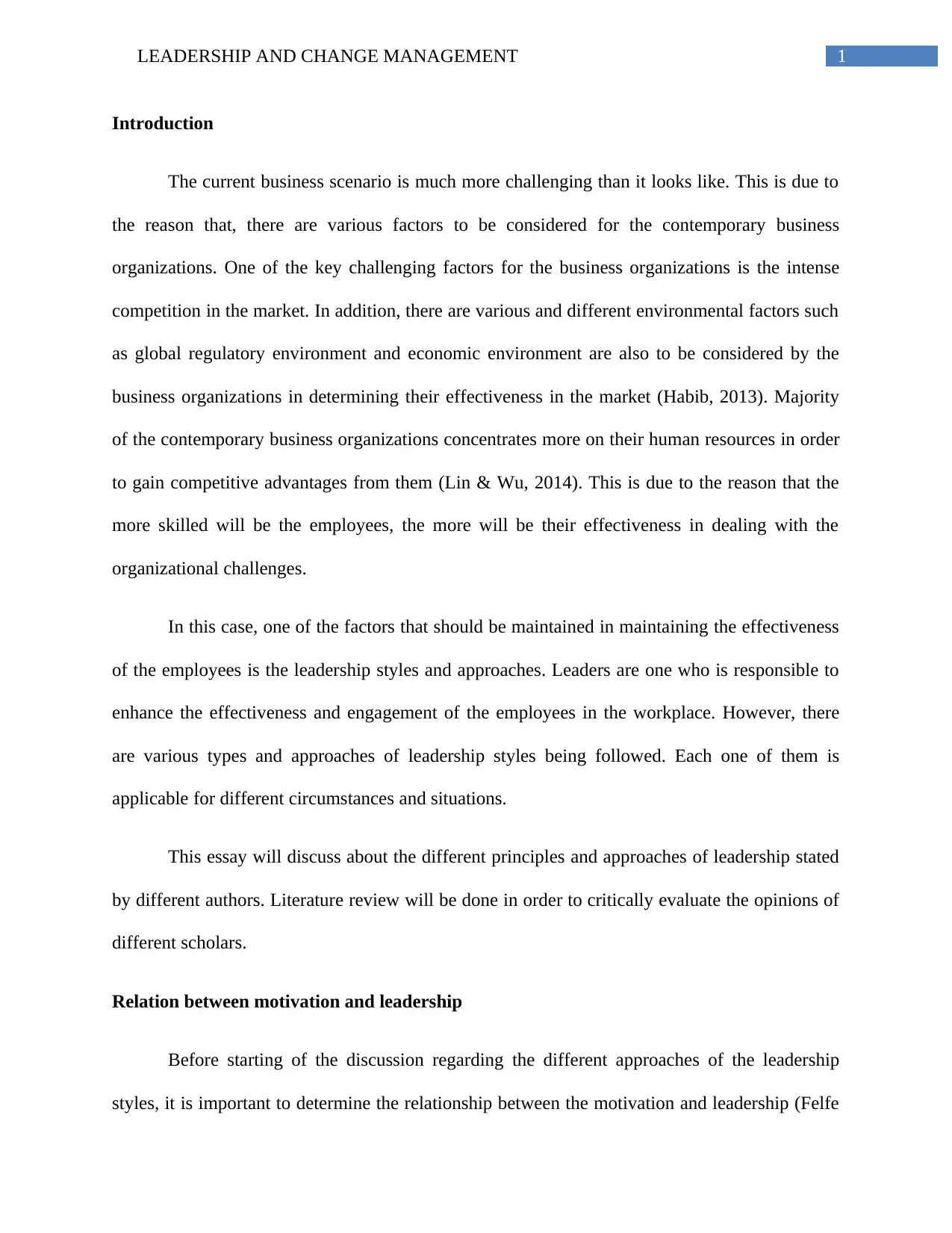
1LEADERSHIP AND CHANGE MANAGEMENT
Introduction
The current business scenario is much more challenging than it looks like. This is due to
the reason that, there are various factors to be considered for the contemporary business
organizations. One of the key challenging factors for the business organizations is the intense
competition in the market. In addition, there are various and different environmental factors such
as global regulatory environment and economic environment are also to be considered by the
business organizations in determining their effectiveness in the market (Habib, 2013). Majority
of the contemporary business organizations concentrates more on their human resources in order
to gain competitive advantages from them (Lin & Wu, 2014). This is due to the reason that the
more skilled will be the employees, the more will be their effectiveness in dealing with the
organizational challenges.
In this case, one of the factors that should be maintained in maintaining the effectiveness
of the employees is the leadership styles and approaches. Leaders are one who is responsible to
enhance the effectiveness and engagement of the employees in the workplace. However, there
are various types and approaches of leadership styles being followed. Each one of them is
applicable for different circumstances and situations.
This essay will discuss about the different principles and approaches of leadership stated
by different authors. Literature review will be done in order to critically evaluate the opinions of
different scholars.
Relation between motivation and leadership
Before starting of the discussion regarding the different approaches of the leadership
styles, it is important to determine the relationship between the motivation and leadership (Felfe
Introduction
The current business scenario is much more challenging than it looks like. This is due to
the reason that, there are various factors to be considered for the contemporary business
organizations. One of the key challenging factors for the business organizations is the intense
competition in the market. In addition, there are various and different environmental factors such
as global regulatory environment and economic environment are also to be considered by the
business organizations in determining their effectiveness in the market (Habib, 2013). Majority
of the contemporary business organizations concentrates more on their human resources in order
to gain competitive advantages from them (Lin & Wu, 2014). This is due to the reason that the
more skilled will be the employees, the more will be their effectiveness in dealing with the
organizational challenges.
In this case, one of the factors that should be maintained in maintaining the effectiveness
of the employees is the leadership styles and approaches. Leaders are one who is responsible to
enhance the effectiveness and engagement of the employees in the workplace. However, there
are various types and approaches of leadership styles being followed. Each one of them is
applicable for different circumstances and situations.
This essay will discuss about the different principles and approaches of leadership stated
by different authors. Literature review will be done in order to critically evaluate the opinions of
different scholars.
Relation between motivation and leadership
Before starting of the discussion regarding the different approaches of the leadership
styles, it is important to determine the relationship between the motivation and leadership (Felfe
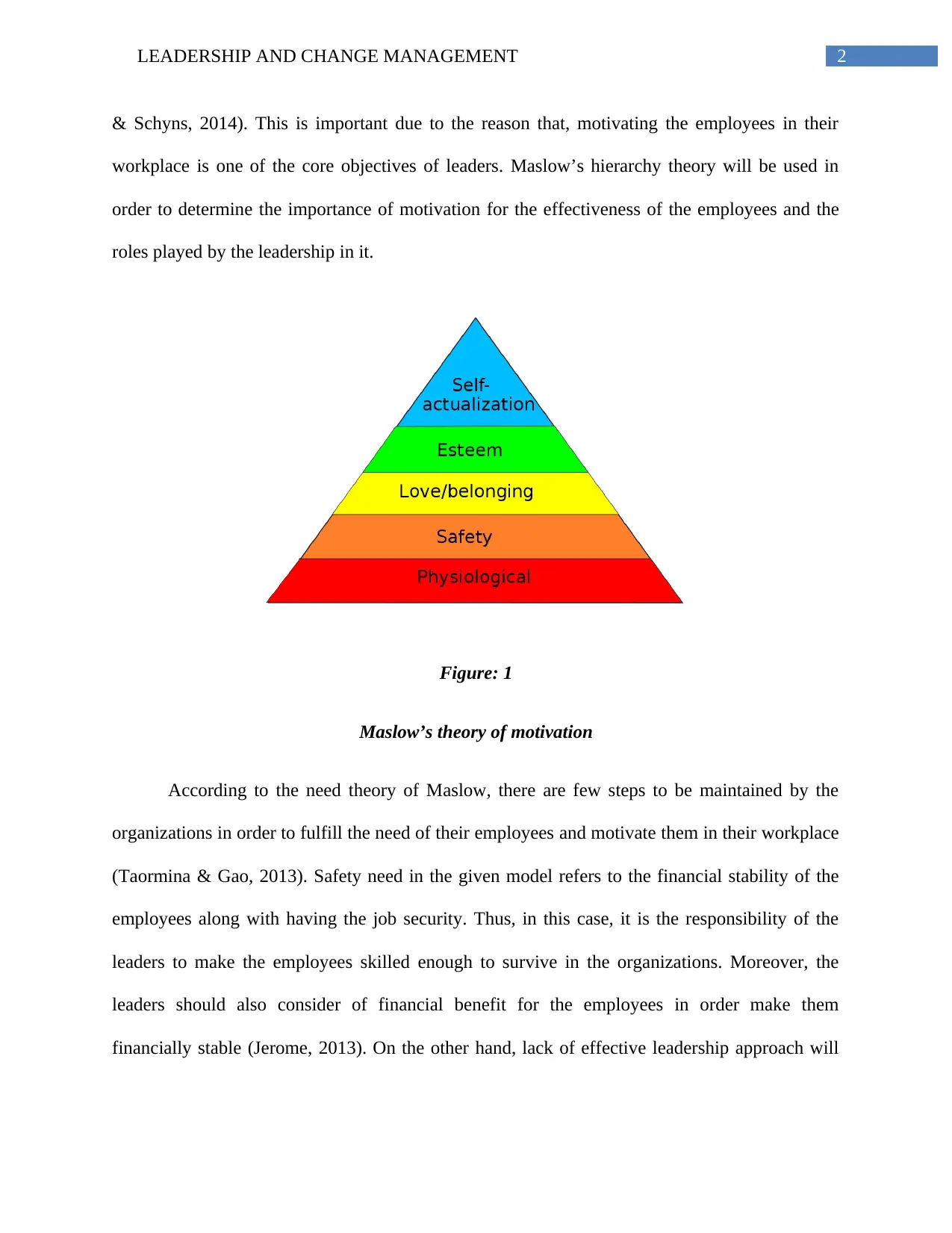
2LEADERSHIP AND CHANGE MANAGEMENT
& Schyns, 2014). This is important due to the reason that, motivating the employees in their
workplace is one of the core objectives of leaders. Maslow’s hierarchy theory will be used in
order to determine the importance of motivation for the effectiveness of the employees and the
roles played by the leadership in it.
Figure: 1
Maslow’s theory of motivation
According to the need theory of Maslow, there are few steps to be maintained by the
organizations in order to fulfill the need of their employees and motivate them in their workplace
(Taormina & Gao, 2013). Safety need in the given model refers to the financial stability of the
employees along with having the job security. Thus, in this case, it is the responsibility of the
leaders to make the employees skilled enough to survive in the organizations. Moreover, the
leaders should also consider of financial benefit for the employees in order make them
financially stable (Jerome, 2013). On the other hand, lack of effective leadership approach will
& Schyns, 2014). This is important due to the reason that, motivating the employees in their
workplace is one of the core objectives of leaders. Maslow’s hierarchy theory will be used in
order to determine the importance of motivation for the effectiveness of the employees and the
roles played by the leadership in it.
Figure: 1
Maslow’s theory of motivation
According to the need theory of Maslow, there are few steps to be maintained by the
organizations in order to fulfill the need of their employees and motivate them in their workplace
(Taormina & Gao, 2013). Safety need in the given model refers to the financial stability of the
employees along with having the job security. Thus, in this case, it is the responsibility of the
leaders to make the employees skilled enough to survive in the organizations. Moreover, the
leaders should also consider of financial benefit for the employees in order make them
financially stable (Jerome, 2013). On the other hand, lack of effective leadership approach will
⊘ This is a preview!⊘
Do you want full access?
Subscribe today to unlock all pages.

Trusted by 1+ million students worldwide
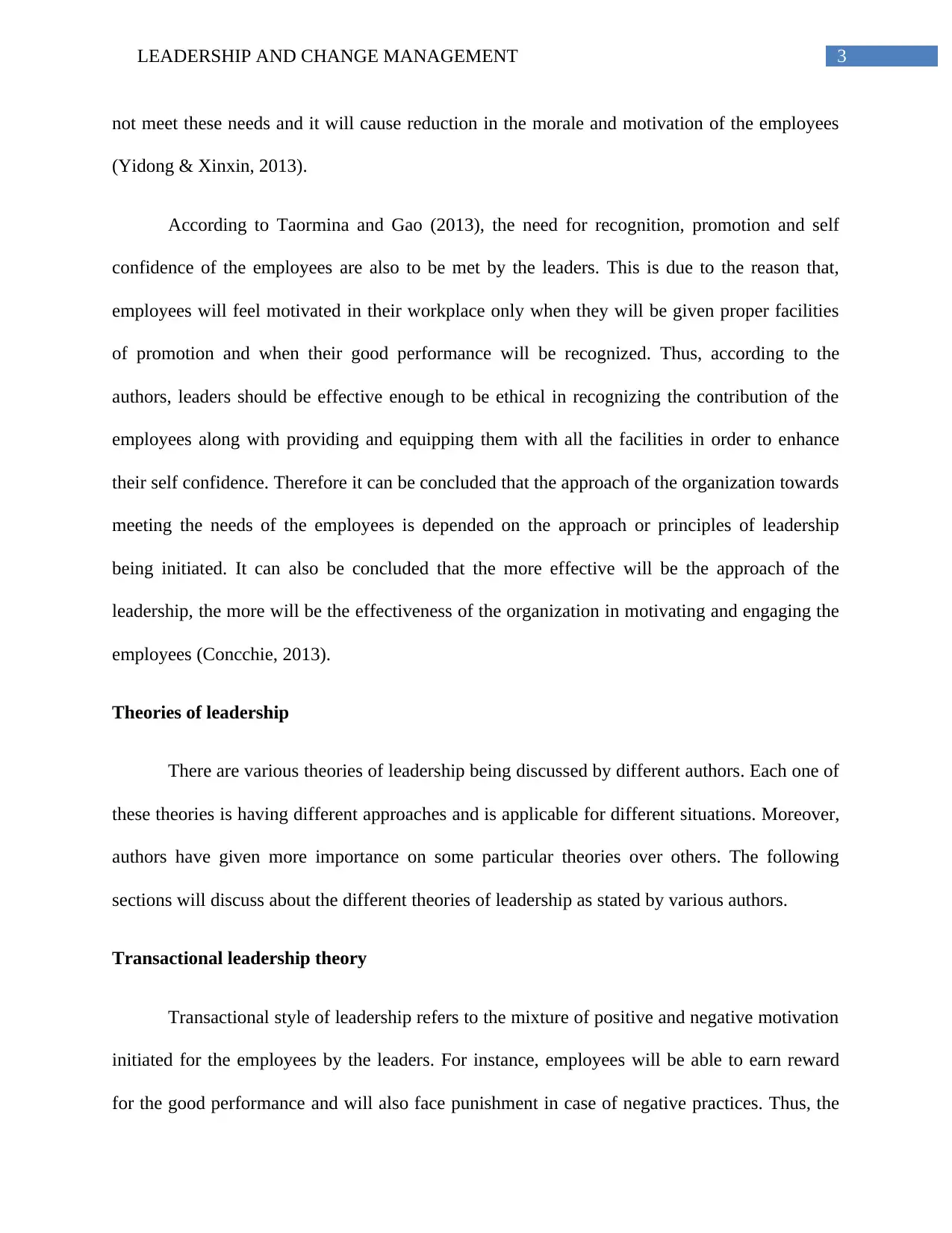
3LEADERSHIP AND CHANGE MANAGEMENT
not meet these needs and it will cause reduction in the morale and motivation of the employees
(Yidong & Xinxin, 2013).
According to Taormina and Gao (2013), the need for recognition, promotion and self
confidence of the employees are also to be met by the leaders. This is due to the reason that,
employees will feel motivated in their workplace only when they will be given proper facilities
of promotion and when their good performance will be recognized. Thus, according to the
authors, leaders should be effective enough to be ethical in recognizing the contribution of the
employees along with providing and equipping them with all the facilities in order to enhance
their self confidence. Therefore it can be concluded that the approach of the organization towards
meeting the needs of the employees is depended on the approach or principles of leadership
being initiated. It can also be concluded that the more effective will be the approach of the
leadership, the more will be the effectiveness of the organization in motivating and engaging the
employees (Concchie, 2013).
Theories of leadership
There are various theories of leadership being discussed by different authors. Each one of
these theories is having different approaches and is applicable for different situations. Moreover,
authors have given more importance on some particular theories over others. The following
sections will discuss about the different theories of leadership as stated by various authors.
Transactional leadership theory
Transactional style of leadership refers to the mixture of positive and negative motivation
initiated for the employees by the leaders. For instance, employees will be able to earn reward
for the good performance and will also face punishment in case of negative practices. Thus, the
not meet these needs and it will cause reduction in the morale and motivation of the employees
(Yidong & Xinxin, 2013).
According to Taormina and Gao (2013), the need for recognition, promotion and self
confidence of the employees are also to be met by the leaders. This is due to the reason that,
employees will feel motivated in their workplace only when they will be given proper facilities
of promotion and when their good performance will be recognized. Thus, according to the
authors, leaders should be effective enough to be ethical in recognizing the contribution of the
employees along with providing and equipping them with all the facilities in order to enhance
their self confidence. Therefore it can be concluded that the approach of the organization towards
meeting the needs of the employees is depended on the approach or principles of leadership
being initiated. It can also be concluded that the more effective will be the approach of the
leadership, the more will be the effectiveness of the organization in motivating and engaging the
employees (Concchie, 2013).
Theories of leadership
There are various theories of leadership being discussed by different authors. Each one of
these theories is having different approaches and is applicable for different situations. Moreover,
authors have given more importance on some particular theories over others. The following
sections will discuss about the different theories of leadership as stated by various authors.
Transactional leadership theory
Transactional style of leadership refers to the mixture of positive and negative motivation
initiated for the employees by the leaders. For instance, employees will be able to earn reward
for the good performance and will also face punishment in case of negative practices. Thus, the
Paraphrase This Document
Need a fresh take? Get an instant paraphrase of this document with our AI Paraphraser
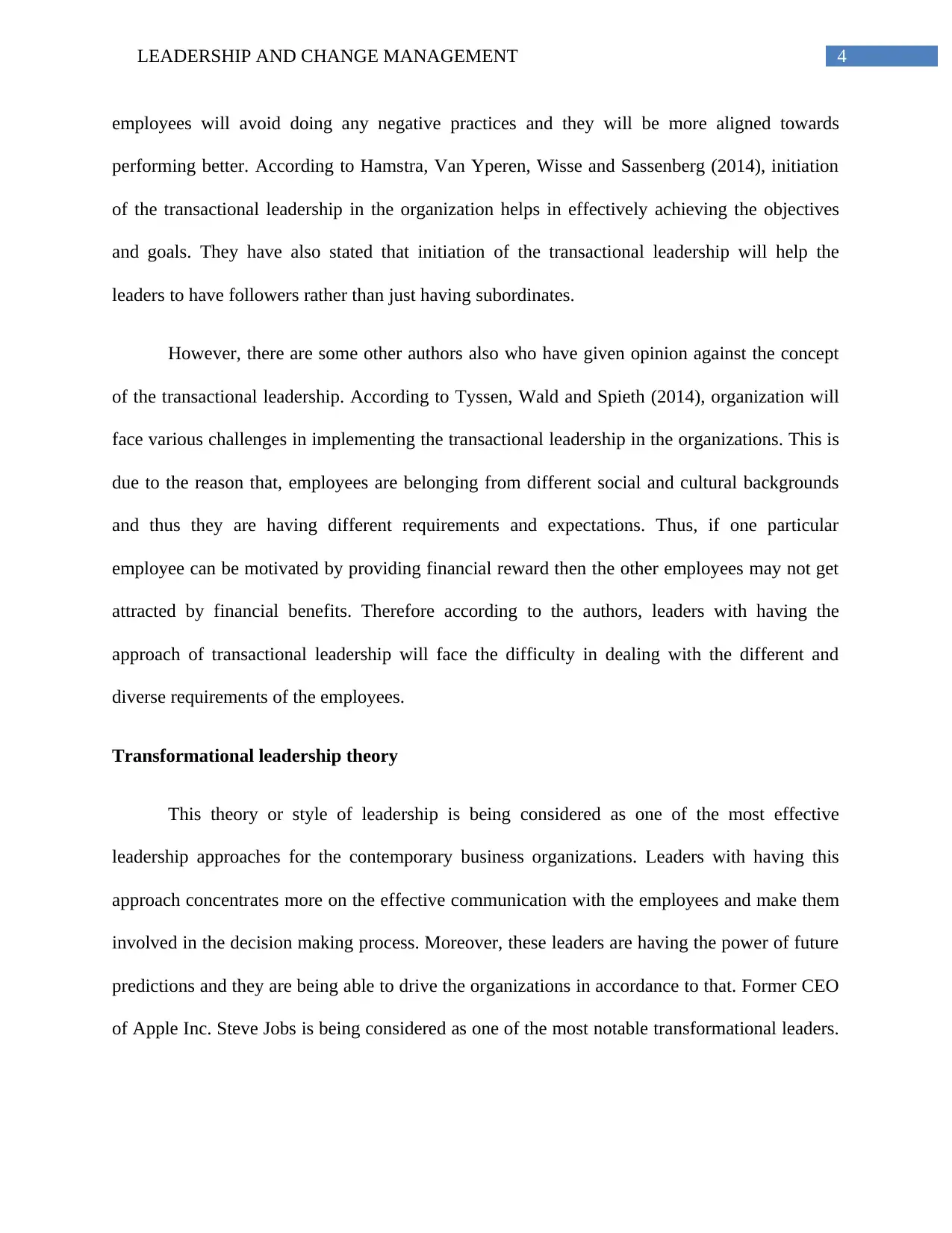
4LEADERSHIP AND CHANGE MANAGEMENT
employees will avoid doing any negative practices and they will be more aligned towards
performing better. According to Hamstra, Van Yperen, Wisse and Sassenberg (2014), initiation
of the transactional leadership in the organization helps in effectively achieving the objectives
and goals. They have also stated that initiation of the transactional leadership will help the
leaders to have followers rather than just having subordinates.
However, there are some other authors also who have given opinion against the concept
of the transactional leadership. According to Tyssen, Wald and Spieth (2014), organization will
face various challenges in implementing the transactional leadership in the organizations. This is
due to the reason that, employees are belonging from different social and cultural backgrounds
and thus they are having different requirements and expectations. Thus, if one particular
employee can be motivated by providing financial reward then the other employees may not get
attracted by financial benefits. Therefore according to the authors, leaders with having the
approach of transactional leadership will face the difficulty in dealing with the different and
diverse requirements of the employees.
Transformational leadership theory
This theory or style of leadership is being considered as one of the most effective
leadership approaches for the contemporary business organizations. Leaders with having this
approach concentrates more on the effective communication with the employees and make them
involved in the decision making process. Moreover, these leaders are having the power of future
predictions and they are being able to drive the organizations in accordance to that. Former CEO
of Apple Inc. Steve Jobs is being considered as one of the most notable transformational leaders.
employees will avoid doing any negative practices and they will be more aligned towards
performing better. According to Hamstra, Van Yperen, Wisse and Sassenberg (2014), initiation
of the transactional leadership in the organization helps in effectively achieving the objectives
and goals. They have also stated that initiation of the transactional leadership will help the
leaders to have followers rather than just having subordinates.
However, there are some other authors also who have given opinion against the concept
of the transactional leadership. According to Tyssen, Wald and Spieth (2014), organization will
face various challenges in implementing the transactional leadership in the organizations. This is
due to the reason that, employees are belonging from different social and cultural backgrounds
and thus they are having different requirements and expectations. Thus, if one particular
employee can be motivated by providing financial reward then the other employees may not get
attracted by financial benefits. Therefore according to the authors, leaders with having the
approach of transactional leadership will face the difficulty in dealing with the different and
diverse requirements of the employees.
Transformational leadership theory
This theory or style of leadership is being considered as one of the most effective
leadership approaches for the contemporary business organizations. Leaders with having this
approach concentrates more on the effective communication with the employees and make them
involved in the decision making process. Moreover, these leaders are having the power of future
predictions and they are being able to drive the organizations in accordance to that. Former CEO
of Apple Inc. Steve Jobs is being considered as one of the most notable transformational leaders.
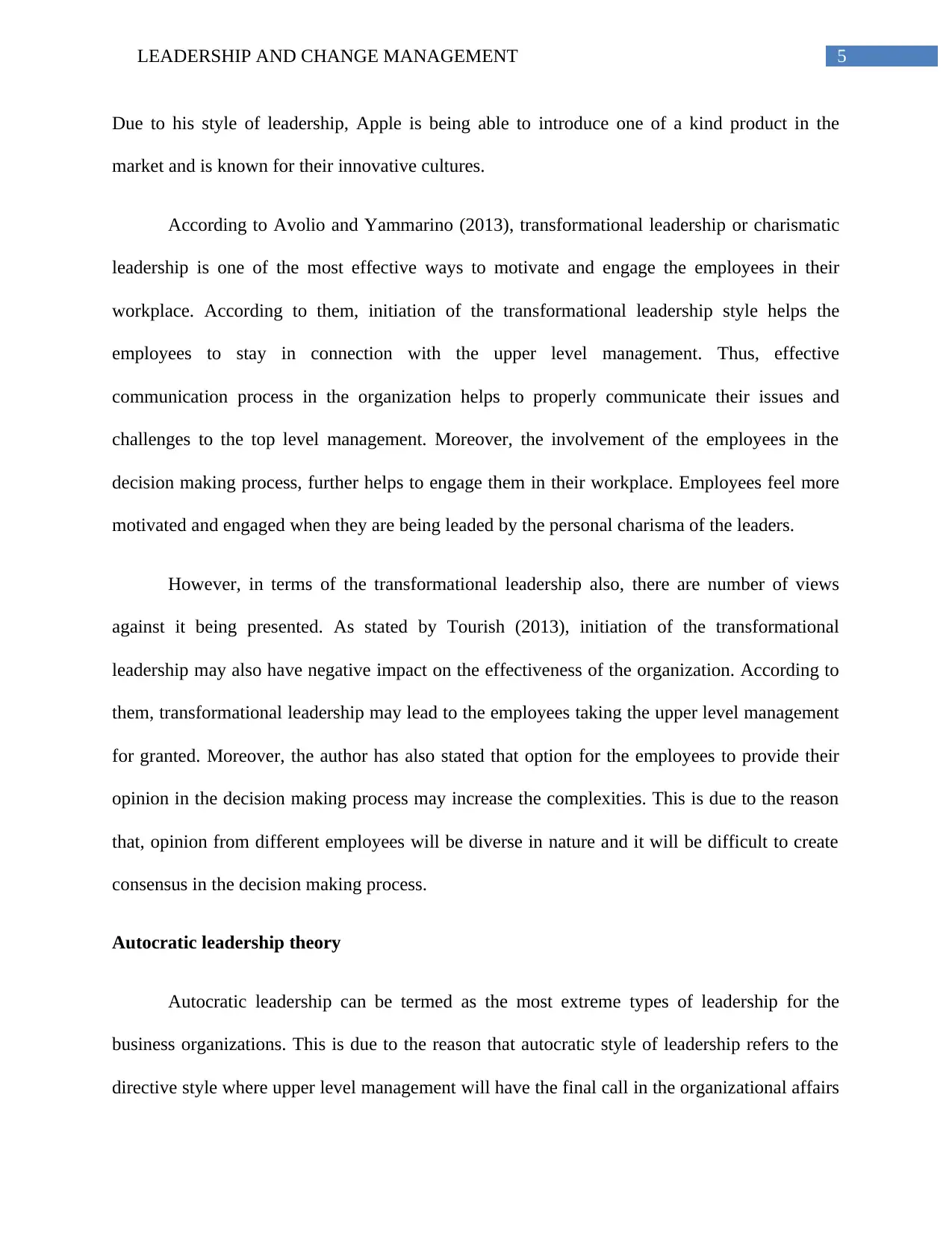
5LEADERSHIP AND CHANGE MANAGEMENT
Due to his style of leadership, Apple is being able to introduce one of a kind product in the
market and is known for their innovative cultures.
According to Avolio and Yammarino (2013), transformational leadership or charismatic
leadership is one of the most effective ways to motivate and engage the employees in their
workplace. According to them, initiation of the transformational leadership style helps the
employees to stay in connection with the upper level management. Thus, effective
communication process in the organization helps to properly communicate their issues and
challenges to the top level management. Moreover, the involvement of the employees in the
decision making process, further helps to engage them in their workplace. Employees feel more
motivated and engaged when they are being leaded by the personal charisma of the leaders.
However, in terms of the transformational leadership also, there are number of views
against it being presented. As stated by Tourish (2013), initiation of the transformational
leadership may also have negative impact on the effectiveness of the organization. According to
them, transformational leadership may lead to the employees taking the upper level management
for granted. Moreover, the author has also stated that option for the employees to provide their
opinion in the decision making process may increase the complexities. This is due to the reason
that, opinion from different employees will be diverse in nature and it will be difficult to create
consensus in the decision making process.
Autocratic leadership theory
Autocratic leadership can be termed as the most extreme types of leadership for the
business organizations. This is due to the reason that autocratic style of leadership refers to the
directive style where upper level management will have the final call in the organizational affairs
Due to his style of leadership, Apple is being able to introduce one of a kind product in the
market and is known for their innovative cultures.
According to Avolio and Yammarino (2013), transformational leadership or charismatic
leadership is one of the most effective ways to motivate and engage the employees in their
workplace. According to them, initiation of the transformational leadership style helps the
employees to stay in connection with the upper level management. Thus, effective
communication process in the organization helps to properly communicate their issues and
challenges to the top level management. Moreover, the involvement of the employees in the
decision making process, further helps to engage them in their workplace. Employees feel more
motivated and engaged when they are being leaded by the personal charisma of the leaders.
However, in terms of the transformational leadership also, there are number of views
against it being presented. As stated by Tourish (2013), initiation of the transformational
leadership may also have negative impact on the effectiveness of the organization. According to
them, transformational leadership may lead to the employees taking the upper level management
for granted. Moreover, the author has also stated that option for the employees to provide their
opinion in the decision making process may increase the complexities. This is due to the reason
that, opinion from different employees will be diverse in nature and it will be difficult to create
consensus in the decision making process.
Autocratic leadership theory
Autocratic leadership can be termed as the most extreme types of leadership for the
business organizations. This is due to the reason that autocratic style of leadership refers to the
directive style where upper level management will have the final call in the organizational affairs
⊘ This is a preview!⊘
Do you want full access?
Subscribe today to unlock all pages.

Trusted by 1+ million students worldwide
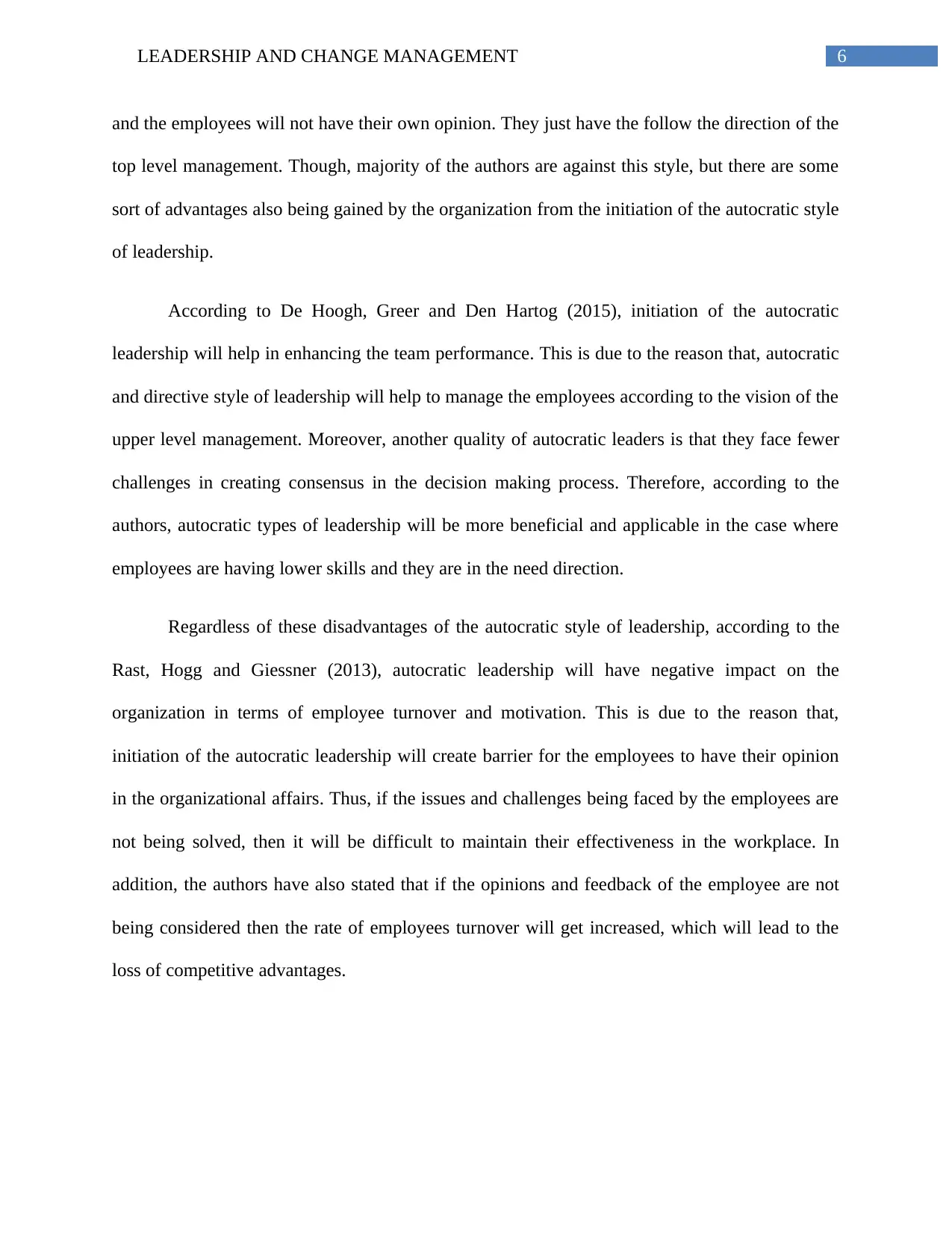
6LEADERSHIP AND CHANGE MANAGEMENT
and the employees will not have their own opinion. They just have the follow the direction of the
top level management. Though, majority of the authors are against this style, but there are some
sort of advantages also being gained by the organization from the initiation of the autocratic style
of leadership.
According to De Hoogh, Greer and Den Hartog (2015), initiation of the autocratic
leadership will help in enhancing the team performance. This is due to the reason that, autocratic
and directive style of leadership will help to manage the employees according to the vision of the
upper level management. Moreover, another quality of autocratic leaders is that they face fewer
challenges in creating consensus in the decision making process. Therefore, according to the
authors, autocratic types of leadership will be more beneficial and applicable in the case where
employees are having lower skills and they are in the need direction.
Regardless of these disadvantages of the autocratic style of leadership, according to the
Rast, Hogg and Giessner (2013), autocratic leadership will have negative impact on the
organization in terms of employee turnover and motivation. This is due to the reason that,
initiation of the autocratic leadership will create barrier for the employees to have their opinion
in the organizational affairs. Thus, if the issues and challenges being faced by the employees are
not being solved, then it will be difficult to maintain their effectiveness in the workplace. In
addition, the authors have also stated that if the opinions and feedback of the employee are not
being considered then the rate of employees turnover will get increased, which will lead to the
loss of competitive advantages.
and the employees will not have their own opinion. They just have the follow the direction of the
top level management. Though, majority of the authors are against this style, but there are some
sort of advantages also being gained by the organization from the initiation of the autocratic style
of leadership.
According to De Hoogh, Greer and Den Hartog (2015), initiation of the autocratic
leadership will help in enhancing the team performance. This is due to the reason that, autocratic
and directive style of leadership will help to manage the employees according to the vision of the
upper level management. Moreover, another quality of autocratic leaders is that they face fewer
challenges in creating consensus in the decision making process. Therefore, according to the
authors, autocratic types of leadership will be more beneficial and applicable in the case where
employees are having lower skills and they are in the need direction.
Regardless of these disadvantages of the autocratic style of leadership, according to the
Rast, Hogg and Giessner (2013), autocratic leadership will have negative impact on the
organization in terms of employee turnover and motivation. This is due to the reason that,
initiation of the autocratic leadership will create barrier for the employees to have their opinion
in the organizational affairs. Thus, if the issues and challenges being faced by the employees are
not being solved, then it will be difficult to maintain their effectiveness in the workplace. In
addition, the authors have also stated that if the opinions and feedback of the employee are not
being considered then the rate of employees turnover will get increased, which will lead to the
loss of competitive advantages.
Paraphrase This Document
Need a fresh take? Get an instant paraphrase of this document with our AI Paraphraser
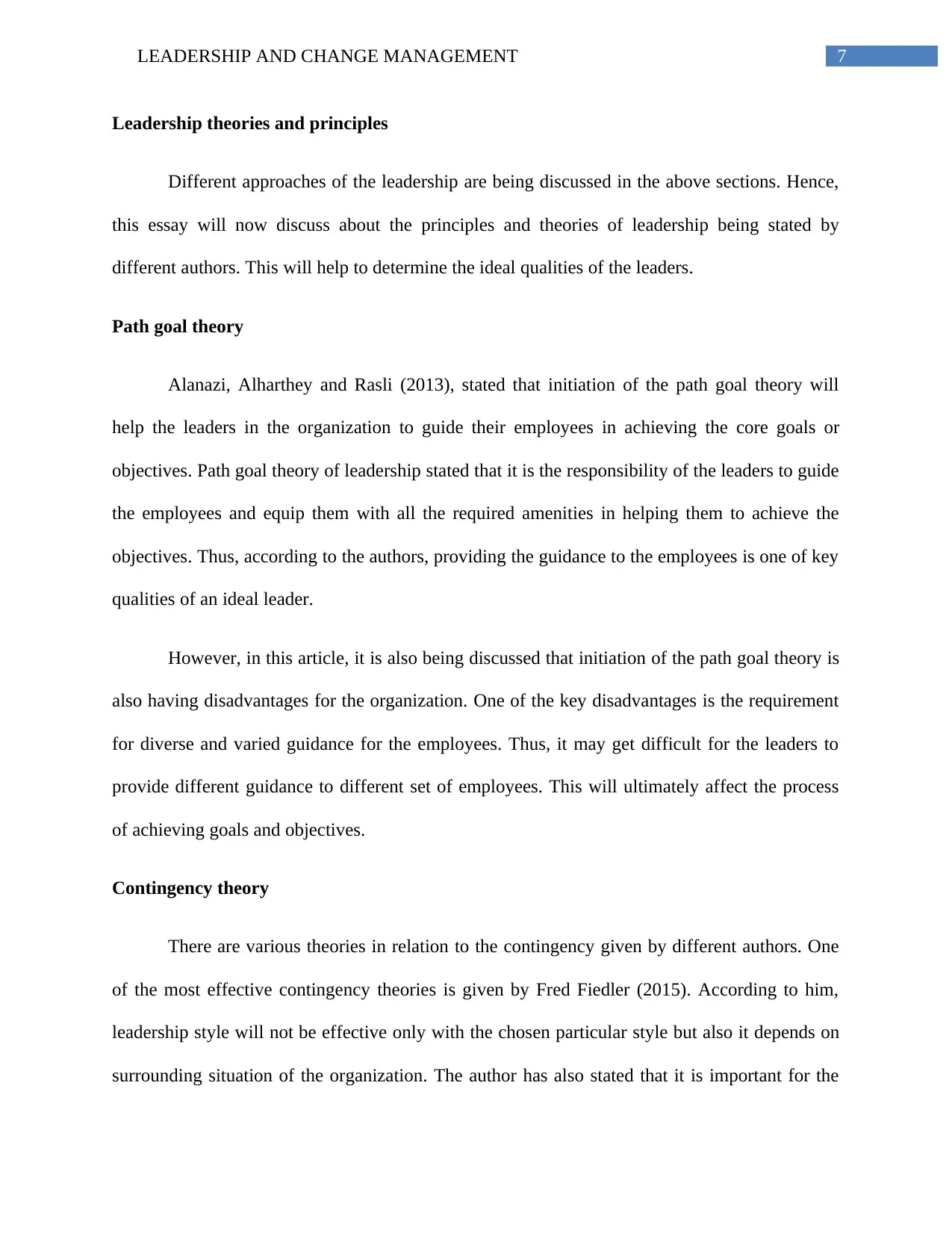
7LEADERSHIP AND CHANGE MANAGEMENT
Leadership theories and principles
Different approaches of the leadership are being discussed in the above sections. Hence,
this essay will now discuss about the principles and theories of leadership being stated by
different authors. This will help to determine the ideal qualities of the leaders.
Path goal theory
Alanazi, Alharthey and Rasli (2013), stated that initiation of the path goal theory will
help the leaders in the organization to guide their employees in achieving the core goals or
objectives. Path goal theory of leadership stated that it is the responsibility of the leaders to guide
the employees and equip them with all the required amenities in helping them to achieve the
objectives. Thus, according to the authors, providing the guidance to the employees is one of key
qualities of an ideal leader.
However, in this article, it is also being discussed that initiation of the path goal theory is
also having disadvantages for the organization. One of the key disadvantages is the requirement
for diverse and varied guidance for the employees. Thus, it may get difficult for the leaders to
provide different guidance to different set of employees. This will ultimately affect the process
of achieving goals and objectives.
Contingency theory
There are various theories in relation to the contingency given by different authors. One
of the most effective contingency theories is given by Fred Fiedler (2015). According to him,
leadership style will not be effective only with the chosen particular style but also it depends on
surrounding situation of the organization. The author has also stated that it is important for the
Leadership theories and principles
Different approaches of the leadership are being discussed in the above sections. Hence,
this essay will now discuss about the principles and theories of leadership being stated by
different authors. This will help to determine the ideal qualities of the leaders.
Path goal theory
Alanazi, Alharthey and Rasli (2013), stated that initiation of the path goal theory will
help the leaders in the organization to guide their employees in achieving the core goals or
objectives. Path goal theory of leadership stated that it is the responsibility of the leaders to guide
the employees and equip them with all the required amenities in helping them to achieve the
objectives. Thus, according to the authors, providing the guidance to the employees is one of key
qualities of an ideal leader.
However, in this article, it is also being discussed that initiation of the path goal theory is
also having disadvantages for the organization. One of the key disadvantages is the requirement
for diverse and varied guidance for the employees. Thus, it may get difficult for the leaders to
provide different guidance to different set of employees. This will ultimately affect the process
of achieving goals and objectives.
Contingency theory
There are various theories in relation to the contingency given by different authors. One
of the most effective contingency theories is given by Fred Fiedler (2015). According to him,
leadership style will not be effective only with the chosen particular style but also it depends on
surrounding situation of the organization. The author has also stated that it is important for the
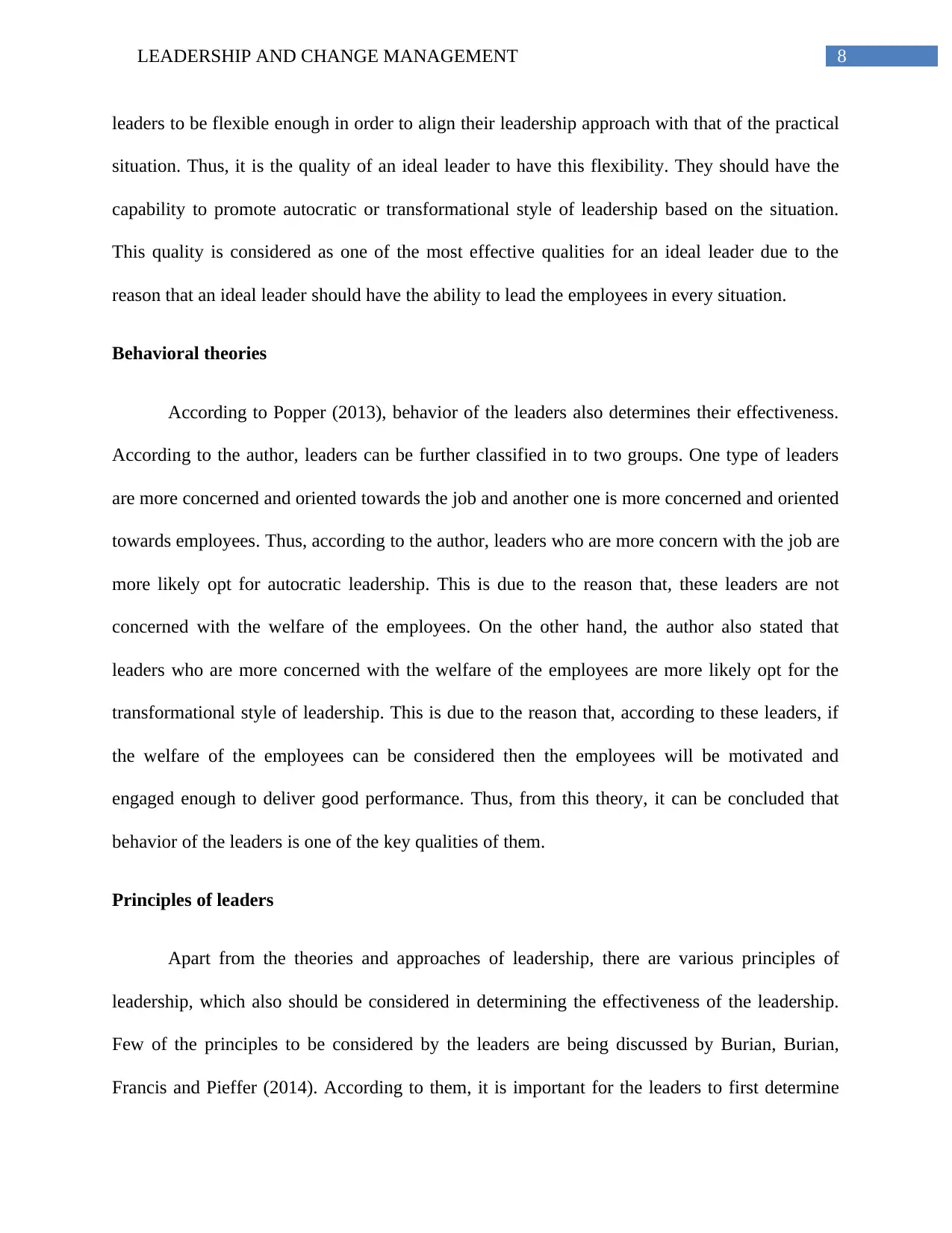
8LEADERSHIP AND CHANGE MANAGEMENT
leaders to be flexible enough in order to align their leadership approach with that of the practical
situation. Thus, it is the quality of an ideal leader to have this flexibility. They should have the
capability to promote autocratic or transformational style of leadership based on the situation.
This quality is considered as one of the most effective qualities for an ideal leader due to the
reason that an ideal leader should have the ability to lead the employees in every situation.
Behavioral theories
According to Popper (2013), behavior of the leaders also determines their effectiveness.
According to the author, leaders can be further classified in to two groups. One type of leaders
are more concerned and oriented towards the job and another one is more concerned and oriented
towards employees. Thus, according to the author, leaders who are more concern with the job are
more likely opt for autocratic leadership. This is due to the reason that, these leaders are not
concerned with the welfare of the employees. On the other hand, the author also stated that
leaders who are more concerned with the welfare of the employees are more likely opt for the
transformational style of leadership. This is due to the reason that, according to these leaders, if
the welfare of the employees can be considered then the employees will be motivated and
engaged enough to deliver good performance. Thus, from this theory, it can be concluded that
behavior of the leaders is one of the key qualities of them.
Principles of leaders
Apart from the theories and approaches of leadership, there are various principles of
leadership, which also should be considered in determining the effectiveness of the leadership.
Few of the principles to be considered by the leaders are being discussed by Burian, Burian,
Francis and Pieffer (2014). According to them, it is important for the leaders to first determine
leaders to be flexible enough in order to align their leadership approach with that of the practical
situation. Thus, it is the quality of an ideal leader to have this flexibility. They should have the
capability to promote autocratic or transformational style of leadership based on the situation.
This quality is considered as one of the most effective qualities for an ideal leader due to the
reason that an ideal leader should have the ability to lead the employees in every situation.
Behavioral theories
According to Popper (2013), behavior of the leaders also determines their effectiveness.
According to the author, leaders can be further classified in to two groups. One type of leaders
are more concerned and oriented towards the job and another one is more concerned and oriented
towards employees. Thus, according to the author, leaders who are more concern with the job are
more likely opt for autocratic leadership. This is due to the reason that, these leaders are not
concerned with the welfare of the employees. On the other hand, the author also stated that
leaders who are more concerned with the welfare of the employees are more likely opt for the
transformational style of leadership. This is due to the reason that, according to these leaders, if
the welfare of the employees can be considered then the employees will be motivated and
engaged enough to deliver good performance. Thus, from this theory, it can be concluded that
behavior of the leaders is one of the key qualities of them.
Principles of leaders
Apart from the theories and approaches of leadership, there are various principles of
leadership, which also should be considered in determining the effectiveness of the leadership.
Few of the principles to be considered by the leaders are being discussed by Burian, Burian,
Francis and Pieffer (2014). According to them, it is important for the leaders to first determine
⊘ This is a preview!⊘
Do you want full access?
Subscribe today to unlock all pages.

Trusted by 1+ million students worldwide
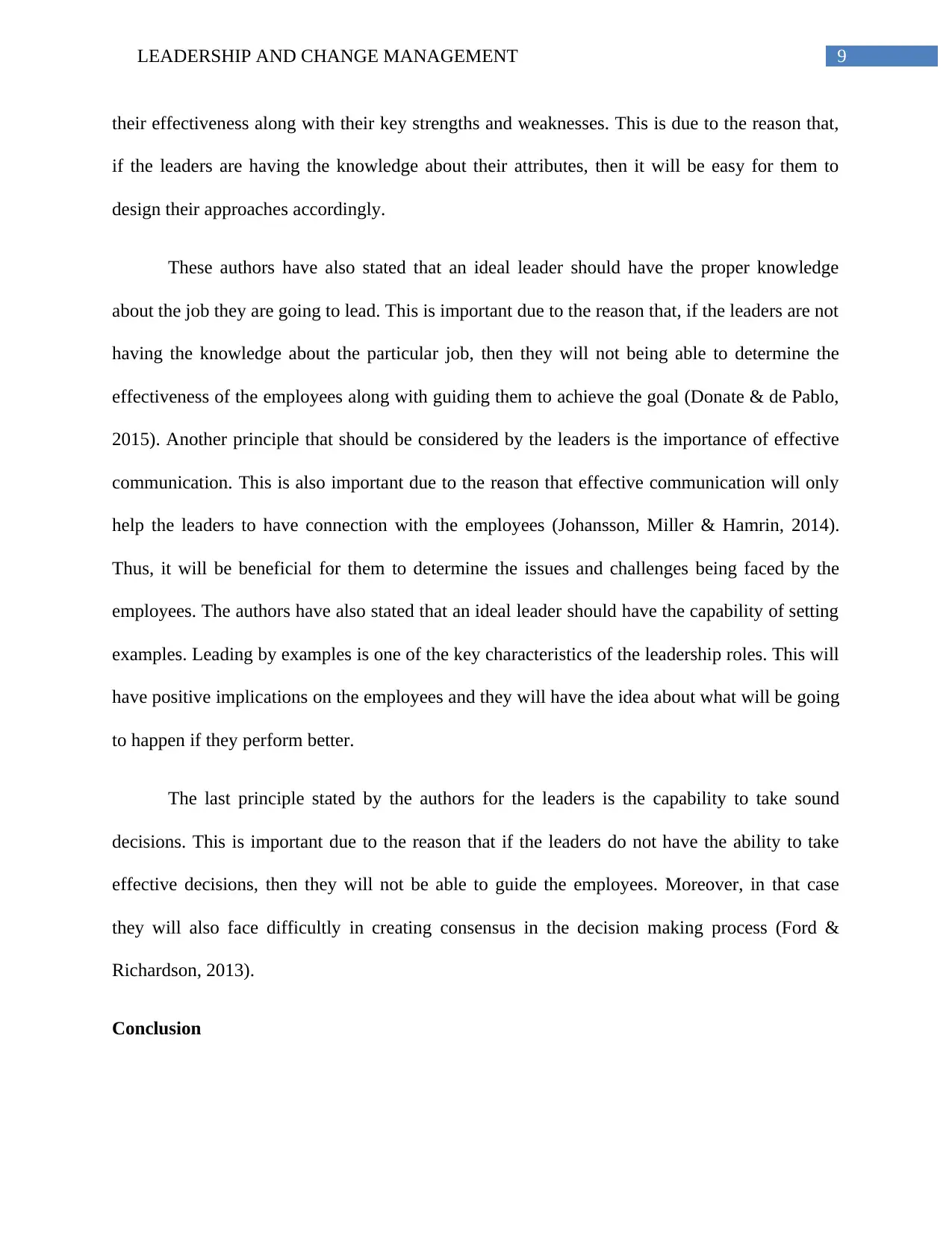
9LEADERSHIP AND CHANGE MANAGEMENT
their effectiveness along with their key strengths and weaknesses. This is due to the reason that,
if the leaders are having the knowledge about their attributes, then it will be easy for them to
design their approaches accordingly.
These authors have also stated that an ideal leader should have the proper knowledge
about the job they are going to lead. This is important due to the reason that, if the leaders are not
having the knowledge about the particular job, then they will not being able to determine the
effectiveness of the employees along with guiding them to achieve the goal (Donate & de Pablo,
2015). Another principle that should be considered by the leaders is the importance of effective
communication. This is also important due to the reason that effective communication will only
help the leaders to have connection with the employees (Johansson, Miller & Hamrin, 2014).
Thus, it will be beneficial for them to determine the issues and challenges being faced by the
employees. The authors have also stated that an ideal leader should have the capability of setting
examples. Leading by examples is one of the key characteristics of the leadership roles. This will
have positive implications on the employees and they will have the idea about what will be going
to happen if they perform better.
The last principle stated by the authors for the leaders is the capability to take sound
decisions. This is important due to the reason that if the leaders do not have the ability to take
effective decisions, then they will not be able to guide the employees. Moreover, in that case
they will also face difficultly in creating consensus in the decision making process (Ford &
Richardson, 2013).
Conclusion
their effectiveness along with their key strengths and weaknesses. This is due to the reason that,
if the leaders are having the knowledge about their attributes, then it will be easy for them to
design their approaches accordingly.
These authors have also stated that an ideal leader should have the proper knowledge
about the job they are going to lead. This is important due to the reason that, if the leaders are not
having the knowledge about the particular job, then they will not being able to determine the
effectiveness of the employees along with guiding them to achieve the goal (Donate & de Pablo,
2015). Another principle that should be considered by the leaders is the importance of effective
communication. This is also important due to the reason that effective communication will only
help the leaders to have connection with the employees (Johansson, Miller & Hamrin, 2014).
Thus, it will be beneficial for them to determine the issues and challenges being faced by the
employees. The authors have also stated that an ideal leader should have the capability of setting
examples. Leading by examples is one of the key characteristics of the leadership roles. This will
have positive implications on the employees and they will have the idea about what will be going
to happen if they perform better.
The last principle stated by the authors for the leaders is the capability to take sound
decisions. This is important due to the reason that if the leaders do not have the ability to take
effective decisions, then they will not be able to guide the employees. Moreover, in that case
they will also face difficultly in creating consensus in the decision making process (Ford &
Richardson, 2013).
Conclusion
Paraphrase This Document
Need a fresh take? Get an instant paraphrase of this document with our AI Paraphraser
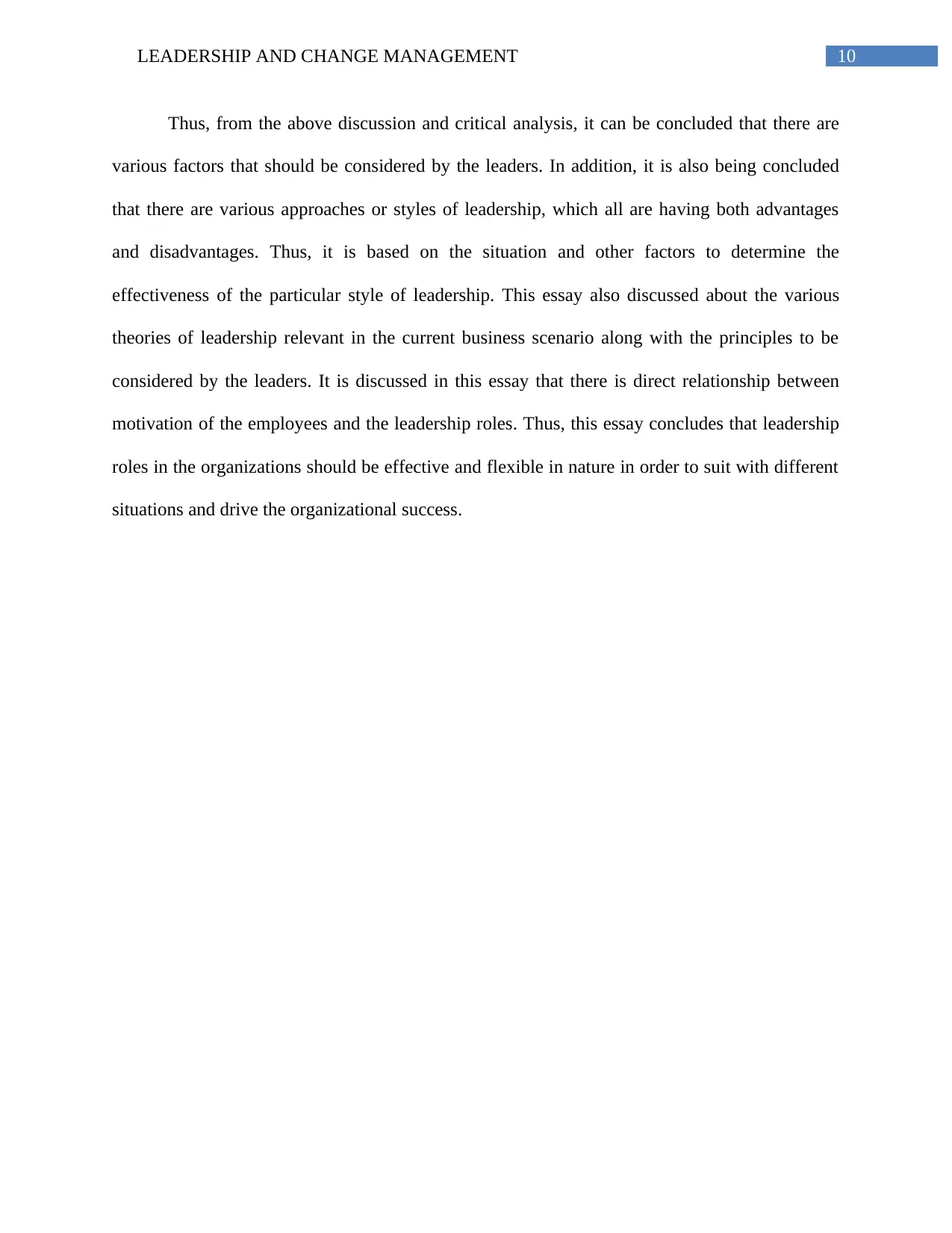
10LEADERSHIP AND CHANGE MANAGEMENT
Thus, from the above discussion and critical analysis, it can be concluded that there are
various factors that should be considered by the leaders. In addition, it is also being concluded
that there are various approaches or styles of leadership, which all are having both advantages
and disadvantages. Thus, it is based on the situation and other factors to determine the
effectiveness of the particular style of leadership. This essay also discussed about the various
theories of leadership relevant in the current business scenario along with the principles to be
considered by the leaders. It is discussed in this essay that there is direct relationship between
motivation of the employees and the leadership roles. Thus, this essay concludes that leadership
roles in the organizations should be effective and flexible in nature in order to suit with different
situations and drive the organizational success.
Thus, from the above discussion and critical analysis, it can be concluded that there are
various factors that should be considered by the leaders. In addition, it is also being concluded
that there are various approaches or styles of leadership, which all are having both advantages
and disadvantages. Thus, it is based on the situation and other factors to determine the
effectiveness of the particular style of leadership. This essay also discussed about the various
theories of leadership relevant in the current business scenario along with the principles to be
considered by the leaders. It is discussed in this essay that there is direct relationship between
motivation of the employees and the leadership roles. Thus, this essay concludes that leadership
roles in the organizations should be effective and flexible in nature in order to suit with different
situations and drive the organizational success.
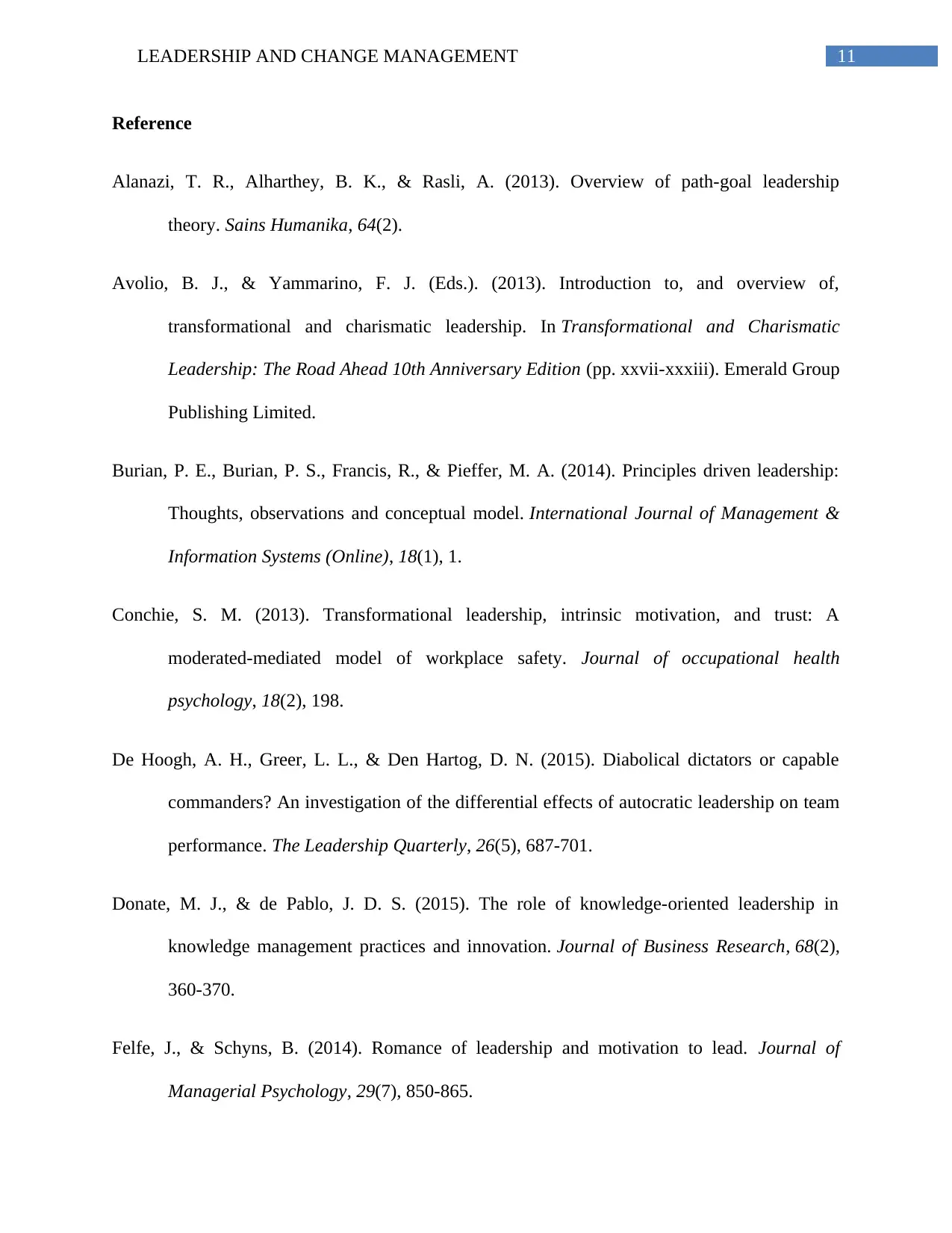
11LEADERSHIP AND CHANGE MANAGEMENT
Reference
Alanazi, T. R., Alharthey, B. K., & Rasli, A. (2013). Overview of path-goal leadership
theory. Sains Humanika, 64(2).
Avolio, B. J., & Yammarino, F. J. (Eds.). (2013). Introduction to, and overview of,
transformational and charismatic leadership. In Transformational and Charismatic
Leadership: The Road Ahead 10th Anniversary Edition (pp. xxvii-xxxiii). Emerald Group
Publishing Limited.
Burian, P. E., Burian, P. S., Francis, R., & Pieffer, M. A. (2014). Principles driven leadership:
Thoughts, observations and conceptual model. International Journal of Management &
Information Systems (Online), 18(1), 1.
Conchie, S. M. (2013). Transformational leadership, intrinsic motivation, and trust: A
moderated-mediated model of workplace safety. Journal of occupational health
psychology, 18(2), 198.
De Hoogh, A. H., Greer, L. L., & Den Hartog, D. N. (2015). Diabolical dictators or capable
commanders? An investigation of the differential effects of autocratic leadership on team
performance. The Leadership Quarterly, 26(5), 687-701.
Donate, M. J., & de Pablo, J. D. S. (2015). The role of knowledge-oriented leadership in
knowledge management practices and innovation. Journal of Business Research, 68(2),
360-370.
Felfe, J., & Schyns, B. (2014). Romance of leadership and motivation to lead. Journal of
Managerial Psychology, 29(7), 850-865.
Reference
Alanazi, T. R., Alharthey, B. K., & Rasli, A. (2013). Overview of path-goal leadership
theory. Sains Humanika, 64(2).
Avolio, B. J., & Yammarino, F. J. (Eds.). (2013). Introduction to, and overview of,
transformational and charismatic leadership. In Transformational and Charismatic
Leadership: The Road Ahead 10th Anniversary Edition (pp. xxvii-xxxiii). Emerald Group
Publishing Limited.
Burian, P. E., Burian, P. S., Francis, R., & Pieffer, M. A. (2014). Principles driven leadership:
Thoughts, observations and conceptual model. International Journal of Management &
Information Systems (Online), 18(1), 1.
Conchie, S. M. (2013). Transformational leadership, intrinsic motivation, and trust: A
moderated-mediated model of workplace safety. Journal of occupational health
psychology, 18(2), 198.
De Hoogh, A. H., Greer, L. L., & Den Hartog, D. N. (2015). Diabolical dictators or capable
commanders? An investigation of the differential effects of autocratic leadership on team
performance. The Leadership Quarterly, 26(5), 687-701.
Donate, M. J., & de Pablo, J. D. S. (2015). The role of knowledge-oriented leadership in
knowledge management practices and innovation. Journal of Business Research, 68(2),
360-370.
Felfe, J., & Schyns, B. (2014). Romance of leadership and motivation to lead. Journal of
Managerial Psychology, 29(7), 850-865.
⊘ This is a preview!⊘
Do you want full access?
Subscribe today to unlock all pages.

Trusted by 1+ million students worldwide
1 out of 14
Related Documents
Your All-in-One AI-Powered Toolkit for Academic Success.
+13062052269
info@desklib.com
Available 24*7 on WhatsApp / Email
![[object Object]](/_next/static/media/star-bottom.7253800d.svg)
Unlock your academic potential
Copyright © 2020–2025 A2Z Services. All Rights Reserved. Developed and managed by ZUCOL.




